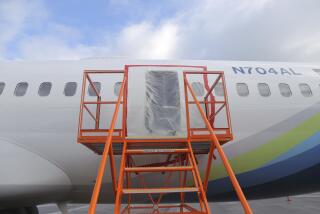Asiana jet’s automated controls working normally before crash
SAN FRANCISCO -- The automated controls that should have assisted Asiana Airlines pilots with their landing at San Francisco International Airport seemed to be working normally when the jetliner slammed into the sea wall and runway, federal investigators said Thursday.
A preliminary investigation into cockpit tools that help pilots set minimum speed and altitude showed “no anomalous behavior,” National Transportation Safety Board Chairwoman Deborah A.P. Hersman said.
The NTSB’s updated information provides a more detailed look inside the cockpit in the moments before the Boeing 777 crashed on Saturday. But it still does not resolve the central question of the crash: Why the Boeing 777’s speed and altitude fell so far out of the normal range for landing before the crash, which killed two people and injured 182 more.
Investigators are finishing their on-scene work at Runway 28L but will continue to analyze pieces of the plane at the NTSB’s labs in Washington, D.C. A report that will officially determine the cause of the crash is expected in about a year. Cranes have removed much of the wreckage.
The pilots, who had been cleared for a manual landing at SFO, told investigators that they had set the plane’s automated throttle to maintain a speed of 137 knots during descent. At an altitude of about 200 feet, they said, they noticed their speed declining and tried to recalibrate, adding more power to the engine.
“There are expectations that the crew is monitoring speed on approach,” Hersman said.
Investigators said the throttles had been set in several different “modes” in the minutes before the crash, possibly to execute angles and speeds dictated by air-traffic control. However, there are some modes for which the auto-throttle on the Boeing 777 does not work to maintain speed.
Hersman said Thursday that crew members said two other times that the plane was coming in too slow and too low. Initial reports had indicated only one call was made, about 1.5 seconds before the crash, to abort the landing and try again; a different crew member also called to abort the landing about three or four seconds before impact.
The plane’s relief pilot also commented on the plane’s sink rate, or descent over time, before the cockpit began making adjustments, Hersman said.
Flying pilot Lee Kang-kook, a veteran who was training on the Boeing 777, initially told the Korean media that he had been temporarily blinded by a bright flash of light just before the landing. That light source did not affect his vision, Hersman said, and seemed to be a reflection of the sun. Lee could still see the flight control instruments; the two other pilots in the cockpit did not mention the light.
The damaged runway could open as early as Sunday, after some segments are repaved and repainted. The instrument landing system, which helps pilots navigate the runway, will be closed until August as pre-scheduled construction on the runways continues.
ALSO:
Three Asiana plane crash victims remain in critical condition
NTSB investigates whether Asiana pilot was blinded before crash
Asiana crash survivor describes aiding injured, long wait for help
More to Read
Sign up for Essential California
The most important California stories and recommendations in your inbox every morning.
You may occasionally receive promotional content from the Los Angeles Times.













